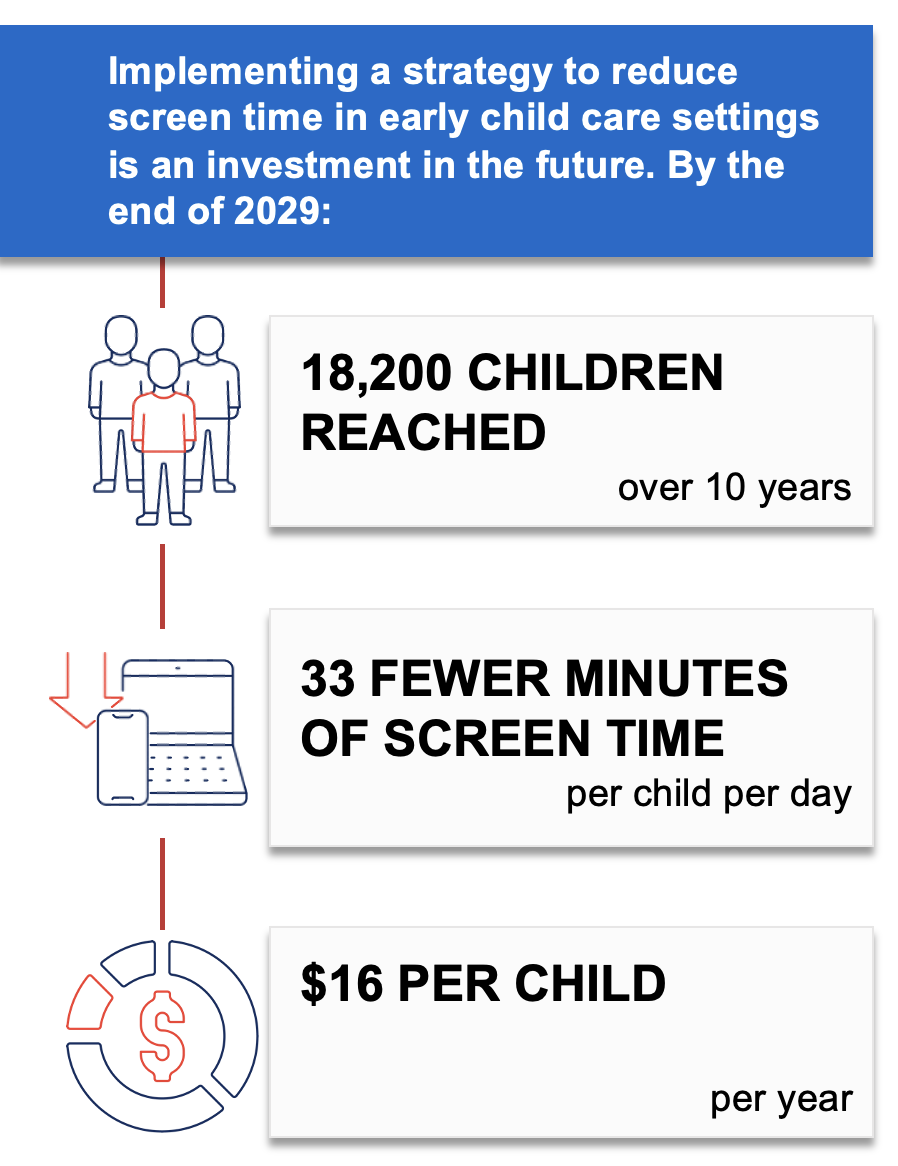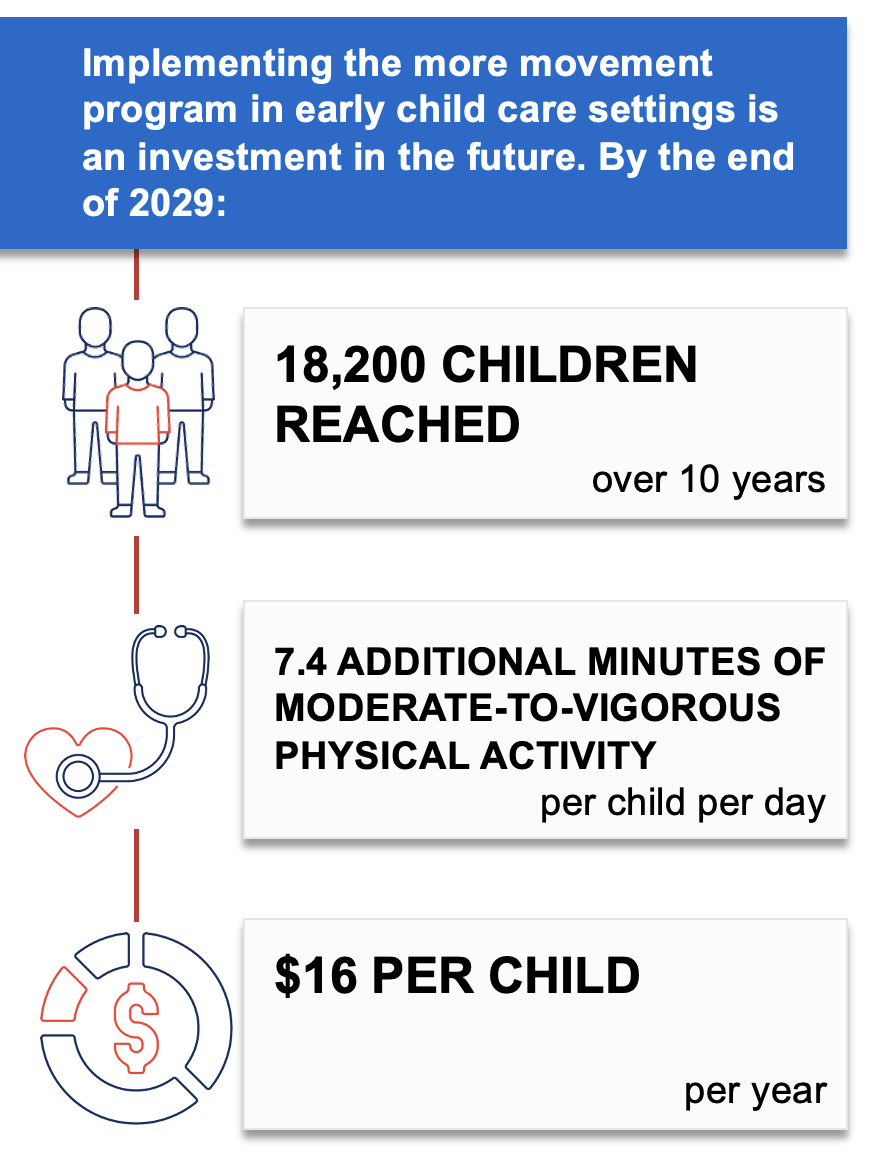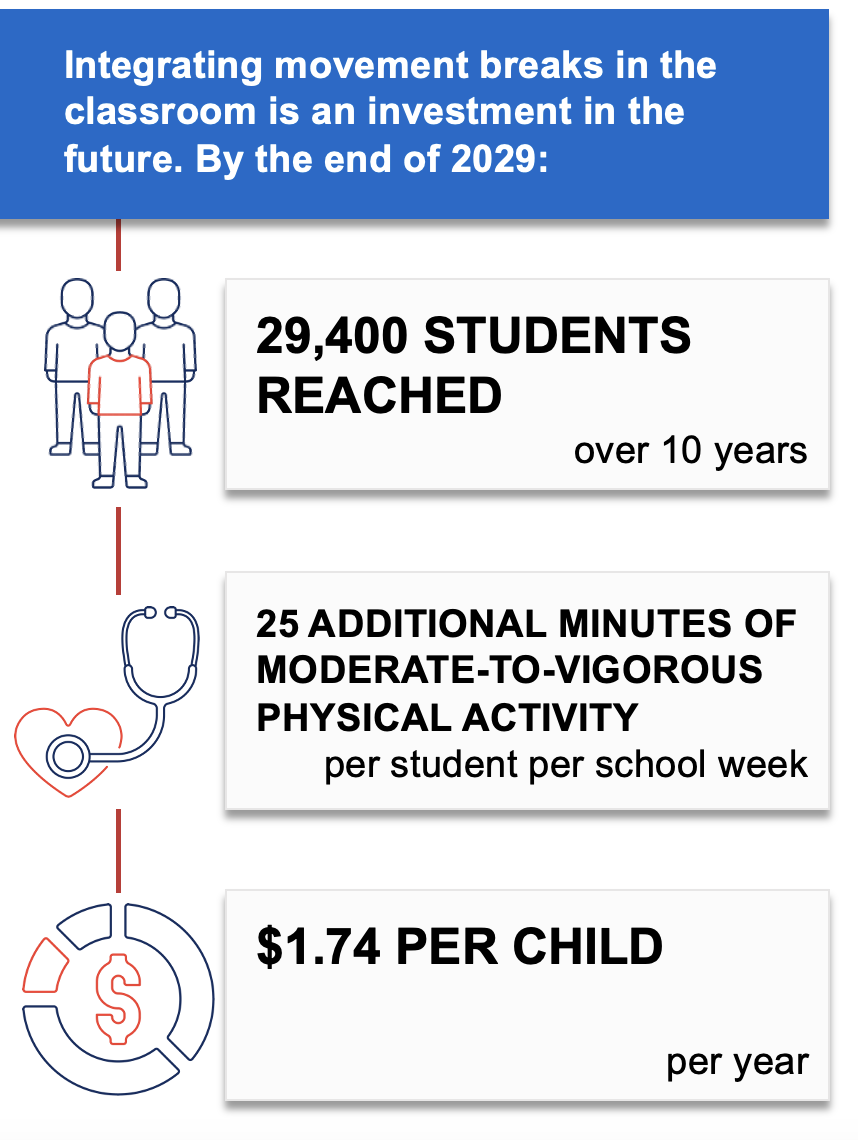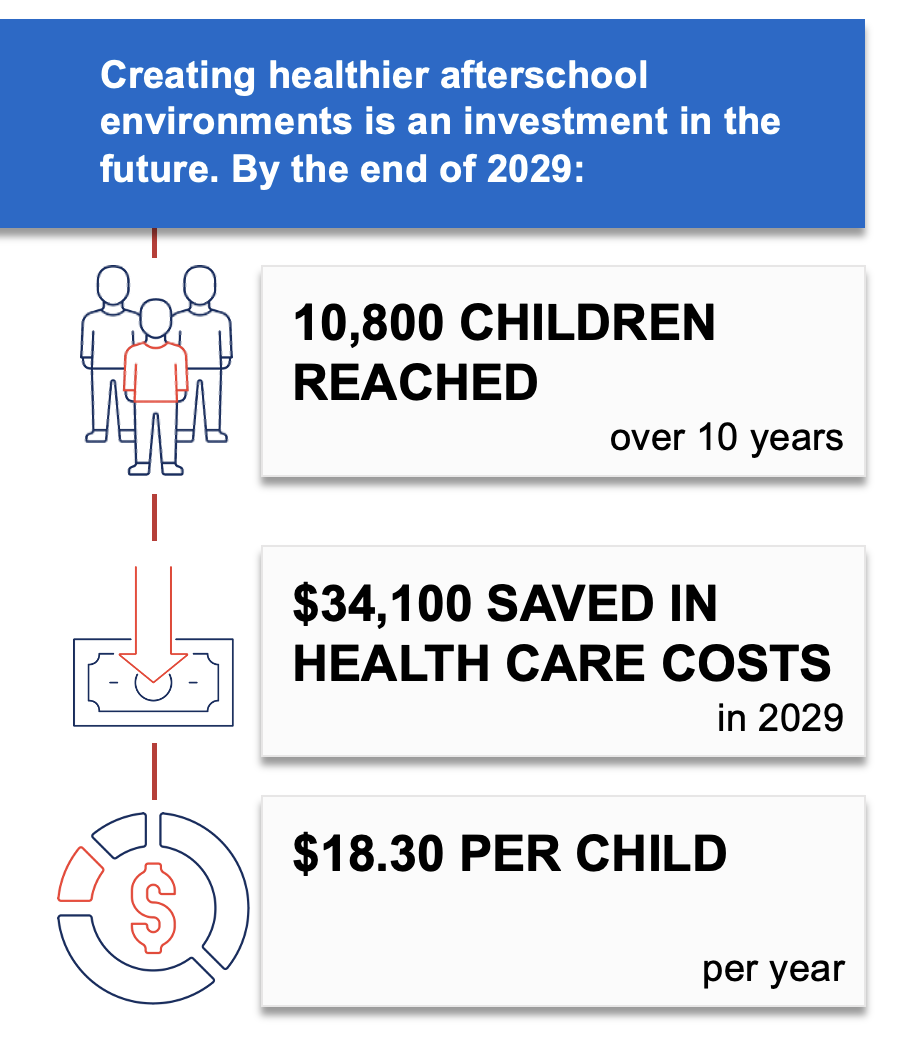The information in this brief is intended only to provide educational information.
The CHOICES Project at the Harvard T.H. Chan School of Public Health and the Boston Public Health Commission (BPHC) worked together as part of the Massachusetts-CHOICES Project (2019 – 2024), a training, technical assistance, and modeling initiative, to develop a playbook of strategies to promote healthy weight and advance health equity in addition to studying how cost-effectiveness metrics are used by partners throughout the state.
Methods & Strategies Modeled
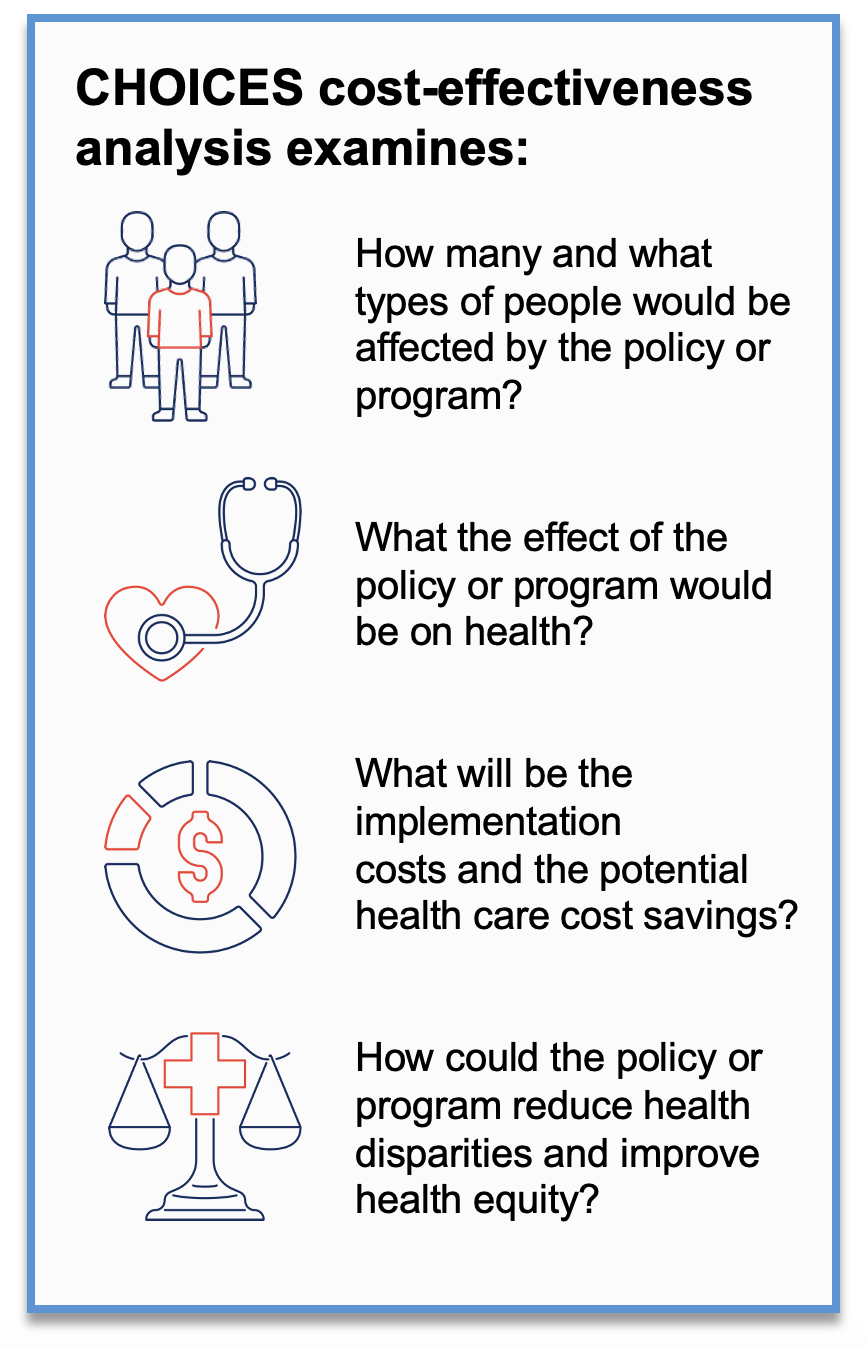 CHOICES uses cost-effectiveness analysis to compare the costs and outcomes of different policies and programs promoting improved nutrition or increased physical activity in schools, early care and education and out-of-school settings, communities, and clinics.
CHOICES uses cost-effectiveness analysis to compare the costs and outcomes of different policies and programs promoting improved nutrition or increased physical activity in schools, early care and education and out-of-school settings, communities, and clinics.
Using CHOICES cost-effectiveness analysis and local data, the BPHC team worked with CHOICES to create a virtual population that mirrors the current population of Boston, MA. Then, the teams examined the expected costs, health outcomes, and health care costs saved if the following strategies were implemented in Boston, Massachusetts over a 10-year timeframe (2020-2029):
• Reducing Screen Time in Early Child Care Settings
• More Movement Program in Early Child Care Settings
• Home Visits to Reduce Screen Time
• Movement Breaks in the Classroom
• Creating Healthier Afterschool Environments (OSNAP)
Reducing Screen Time in Early Child Care Settings
The strategy to reduce screen time in early child care settings involves providing voluntary training to early child care educators and resources to families to limit noneducational television time at child care and home. This strategy could support Boston’s efforts to improve early child care quality through the Boston Healthy Child Care Initiative. It would include training opportunities for early child care educators, offering ongoing support and technical assistance, and providing parents with educational materials that may lead to reducing screen time in young children.1,2
Helping educators to implement practices shown to be effective in reducing television time can help the children in Boston’s early education and care settings engage in fewer minutes of screen time.
Additional Key Findings
If a strategy to reduce screen time in early child care settings was implemented in Boston, 125 cases of obesity would be prevented in 2029, saving $138,000 in health care costs over 10 years.
In addition, this strategy would train and provide technical assistance to early childhood educators on reducing screen time. In the initial training series, this strategy would provide additional skills training and professional development for 1,380 educators and more opportunities to reduce screen time in 570 (100%) child care programs serving 3-5 year olds.
To learn more about this strategy, read the research brief.
- Bovenzi M, Carter S, Sabir M, Bolton AA, Barrett JL, Reiner JF, Cradock AL, Gortmaker SL. Boston, MA: Reducing Screen Time in Early Child Care Settings {Issue Brief}. Boston Public Health Commission and the CHOICES Learning Collaborative Partnership at the Harvard T.H. Chan School of Public Health, Boston, MA; October 2023.
References
1. Mendoza JA, Baranowski T, Jaramillo S, et al. Fit 5 Kids TV Reduction Program for Latino Preschoolers: A Cluster Randomized Controlled Trial. American Journal of Preventive Medicine. 2016;50(5):584-592.<
2. Dennison BA, Russo TJ, Burdick PA, Jenkins PL. An intervention to reduce television viewing by preschool children. Archives of Pediatrics and Adolescent Medicine. 2004;158(2):170-176.
More Movement Program in Early Child Care Settings
The more movement program provides training opportunities and resources for early child care educators to implement actions in their programs to encourage physical activity. This strategy could support Boston’s efforts to improve early child care quality through the Boston Healthy Child Care Initiative. It would include training opportunities for early child care educators in physical activity curricula, provide resources and instructional materials, and support technical assistance opportunities that may lead to higher physical activity levels among young children.1,2
Helping educators implement practices shown to be effective in increasing physical activity can help the children in Boston’s early education and care settings to move more.
Additional Key Findings
If the more movement program in early child care settings was implemented in Boston, 94 cases of obesity would be prevented in 2029, saving $104,000 in health care costs over 10 years. Besides promoting a healthy weight, increasing physical activity is linked to improved bone and muscular health and better gross motor skills in young children.3-5
In addition, this strategy would train and provide technical assistance to early childhood educators. In the initial training series, the more movement program would provide additional skills training and professional development for 1,380 educators and more physical activity promotion opportunities in 570 (100%) child care programs serving 3-5 year olds.
To learn more about this strategy, read the research brief.
- Bovenzi M, Carter S, Sabir M, Bolton AA, Barrett JL, Reiner JF, Cradock AL, Gortmaker SL. Boston, MA: More Movement Program in Early Child Care Settings {Issue Brief}. Boston Public Health Commission and the CHOICES Learning Collaborative Partnership at the Harvard T.H. Chan School of Public Health, Boston, MA; October 2023.
References
1. Fitzgibbon ML, Stolley MR, Schiffer LA, et al. Hip-Hop to Health Jr. Obesity Prevention Effectiveness Trial: Postintervention Results. Obesity (Silver Spring). 2011;19(5):994-1003.
2. Kong A, Buscemi J, Stolley MR, Schiffer LA, Kim Y, Braunschweig CL, Gomez-Perez SL, Blumstein LB, Van Horn L, Dyer AR, Fitzgibbon ML. Hip-Hop to Health Jr. Randomized Effectiveness Trial: 1-Year Follow-up Results. American Journal of Preventive Medicine. 2016 Feb;50(2):136-44.
3. U.S. Dept of Health and Human Services. Physical Activity Guidelines for Americans, 2nd edition. U.S. Dept of Health and Human Services; 2018. Accessed Jul 23, 2021. https://health.gov/sites/default/files/2019-09/Physical_Activity_Guidelines_2nd_edition.pdf
4. Pate RR, Hillman CH, Janz KF, et al. Physical Activity and Health in Children Younger than 6 Years: A Systematic Review. Medicine & Science in Sports & Exercise. 06 2019;51(6):1282-1291.
5. Timmons BW, Leblanc AG, Carson V, et al. Systematic review of physical activity and health in the early years (aged 0-4 years). Applied Physiology, Nutrition, and Metabolism. Aug 2012;37(4):773-92.
Home Visits to Reduce Screen Time
The home visits to reduce screen time strategy aims to reduce the amount of screen time viewed at home by young children. Community health workers would provide counseling and resources on strategies to limit children’s screen time to children and families who participate in home visiting programs.
Through professional development training opportunities, community health workers would learn ways to support families and children in limiting their screen time. During a home visit, community health workers would share the importance of appropriate screen time limits and provide strategies and tools for families to use, including a screen time management device. Integrating this strategy through existing home visiting programs could help more children manage their screen time and grow up at a healthy weight.1
Additional Key Findings
If the home visits to reduce screen time strategy was implemented in Boston, 60 cases of childhood obesity would be prevented in 2029. Besides promoting a healthy weight, this strategy may also benefit children in other ways. Providing children and their families with strategies to move away from their screens allows for more time for activities like reading and active play.
By training and equipping 119 community health workers annually by ensuring that everyone has access to what they need to grow up healthy and strong, this strategy could help reach those families and children that may be at higher risk of having or developing obesity. Children in households with low income could see greater health benefits from this strategy.1
To learn more about this strategy, read the research brief.
- Carter S, Bovenzi M, Sabir M, Bolton AA, Reiner JR, Barrett JL, Cradock AL, Gortmaker SL. Boston, MA: Home Visits to Reduce Screen Time {Issue Brief}. Boston Public Health Commission, Boston, MA, and the CHOICES Learning Collaborative Partnership at the Harvard T.H. Chan School of Public Health, Boston, MA; February 2023.
References
1. Epstein LH, Roemmich JN, Robinson JL, et al. A randomized trial of the effects of reducing television viewing and computer use on body mass index in young children. Arch Pediatr Adolesc Med. Mar 2008;162(3):239-45. doi:10.1001/archpediatrics.2007.45
Movement Breaks in the Classroom
Movement breaks in the classroom is a strategy to promote physical activity during the school day by incorporating five-to-10-minute movement breaks in K-5 public elementary school classrooms. To implement the movement breaks strategy in Boston, teachers, Wellness Champions, and staff would receive training, equipment, and materials to incorporate short activity breaks in the classroom to help children move more.1,2
This aligns with Boston Public School’s (BPS) Physical Education and Physical Activity Policy that requires schools to offer physical activity opportunities during the school day,3 as well as BPS’ Whole School, Whole Community, Whole Child approach, which supports students’ holistic health by promoting positive classroom environments that foster physical activity and learning.
Additional Key Findings
If movement breaks were incorporated into classrooms in Boston, 37 cases of childhood obesity would be prevented in 2029 and save $35,300 in health care costs related to excess weight over 10 years.
By training and equipping over 600 teachers and other school staff yearly to incorporate movement breaks in the classroom, this strategy could help all Boston Public Schools cultivate a positive school climate and improve social emotional learning.4 Participation in movement breaks are associated with students spending more time on task,5 and teachers report that students are more engaged, supportive of each other, and responsive to teacher instructions after participating in a movement break.6
To learn more about this strategy, read the research brief.
- Carter J, Greene J, Neeraja S, Bovenzi, M, Sabir M, Carter S, Bolton AA, Barrett JL, Reiner JR, Cradock AL, Gortmaker SL. Boston, MA: Movement Breaks in the Classroom {Issue Brief}. Boston Public Schools, Boston Public Health Commission, and the CHOICES Learning Collaborative Partnership at the Harvard T.H. Chan School of Public Health, Boston, MA; August 2022.
References
1. Erwin HE, Beighle A, Morgan CF, Noland M. Effect of a low-cost, teacher-directed classroom intervention on elementary students’ physical activity. J Sch Health. 2011;81(8):455-461.
2. Murtagh E, Mulvihill M, Markey O. Bizzy Break! The effect of a classroom-based activity break on in-school physical activity levels of primary school children. Pediatr Exerc Sci. 2013;25(2):300-307.
3. Boston Public Schools. Physical Education & Physical Activity Policy. 2020:8. Superintendent’s Circular. https://drive.google.com/file/d/1rSGwpFaa4LsPKxjhdsHxz2IaXg3ZFVtE/view?usp=embed_facebook
4. School-Based Physical Activity Improves the Social and Emotional Climate for Learning. Centers for Disease Control and Prevention,. Accessed March 9, 2022. https://www.cdc.gov/healthyschools/school_based_pa_se_sel.htm
5. The Community Preventive Services Task Force. Physical Activity: Classroom-based Physical Activity Break Interventions. The Community Guide. 2021:8.
Campbell AL, Lassiter JW. Teacher perceptions of facilitators and barriers to implementing classroom physical activity breaks. J Educ Res. 2020;113(2):108-119
Creating Healthier Afterschool Environments (OSNAP)
The Out of School Nutrition and Physical Activity (OSNAP) initiative helps afterschool programs improve practices and policies that increase physical activity and consumption of healthy snacks.
To implement this initiative, the Boston Public Health Commission would provide professional development opportunities for afterschool program leaders serving students in grades K-5. Afterschool staff leaders would participate in three learning collaborative sessions and receive technical assistance to assess1 and modify their programs’ practices and policies2 to meet the OSNAP nutrition and physical activity goals.
Additional Key Findings
If the OSNAP initiative was implemented in Boston, 37 cases of obesity would be prevented in 2029. It is also projected to be cost-effective at commonly accepted thresholds3 based on net population health improvement related to excess weight ($72,100 per quality-adjusted life year gained).
This strategy may also support children’s health in a variety of other ways. Regular physical activity, healthy eating, and adequate hydration can improve children’s mental and emotional well-being and their heart, lung, and bone health.4 These healthy behaviors can also strengthen students’ attention, memory,5,6 and cognitive functioning,5 all important components for learning and academic performance.
To learn more about this strategy, read the research brief.
- Carter S, Bovenzi M, Clarke J, Bolton AA, Reiner JF, Barrett JL, Cradock AL, Gortmaker SL. Boston, MA: Creating Healthier Afterschool Environments (OSNAP) {Issue Brief}. Boston Public Health Commission, Massachusetts, and the CHOICES Learning Collaborative Partnership at the Harvard T.H. Chan School of Public Health, Boston, MA; July 2023.
References
1. Lee RM, Emmons KM, Okechukwu CA, Barrett JL, Kenney EL, Cradock AL, Giles CM, deBlois ME, Gortmaker SL. Validity of a practitioner-administered observational tool to measure physical activity, nutrition, and screen time in school-age programs. Int J Behav Nutr Phys Act. 2014 Nov 28;11:145. doi: 10.1186/s12966-014-0145-5.
2. Kenney EL, Giles CM, deBlois ME, Gortmaker SL, Chinfatt S, Cradock AL. Improving nutrition and physical activity policies in afterschool programs: results from a group-randomized controlled trial. Prev Med. 2014;66:159-166. doi:10.1016/j.ypmed.2014.06.011
3. Neumann PJ, Cohen JT, Weinstein MC. Updating cost-effectiveness–the curious resilience of the $50,000-per-QALY threshold. New England Journal of Medicine. 2014 Aug 28;371(9):796-7. DOI: 10.1056/NEJMp1405158. PMID: 25162885.
4. Health Benefits of Physical Activity for Children. Centers for Disease Control and Prevention. https://www.cdc.gov/physicalactivity/basics/adults/health-benefits-of-physical-activity-for-children.html. Published Jan 12, 2022. Updated 2022-01-12T05:06:09Z. Accessed Dec 7, 2022.
5. Childhood Nutrition Facts. Centers for Disease Control and Prevention. https://www.cdc.gov/healthyschools/nutrition/facts.htm. Published 2022. Updated 2022-08-05T03:49:26Z. Accessed Dec 12, 2022.
6. Blanding N. Afterschool Programs in Boston, MA, Expand Opportunities for Obesity Prevention. Centers for Disease Control and Prevention; 2016. http://nccd.cdc.gov/nccdsuccessstories
The design for this brief and its graphics were developed by Molly Garrone, MA and partners at Burness.
This document was developed at the Harvard T.H. Chan School of Public Health through the Childhood Obesity Intervention Cost-Effectiveness Study (CHOICES) Learning Collaborative Partnership. This document is intended for educational use only. This work is supported by The JPB Foundation and the Centers for Disease Control and Prevention (U48DP006376). The findings and conclusions are those of the author(s) and do not necessarily represent the official position of the Centers for Disease Control and Prevention or other funders.

